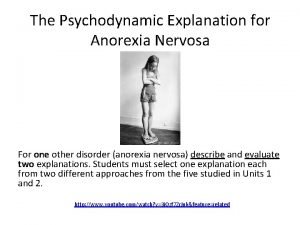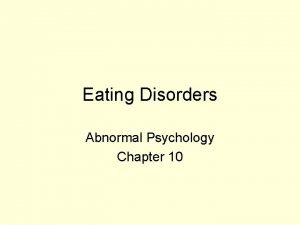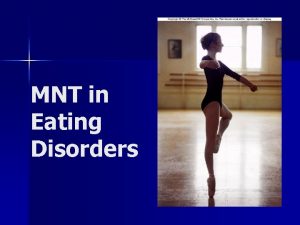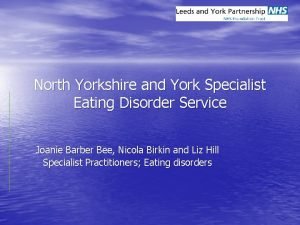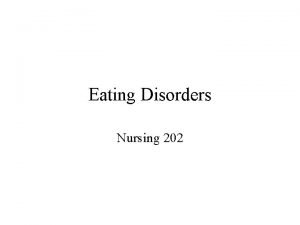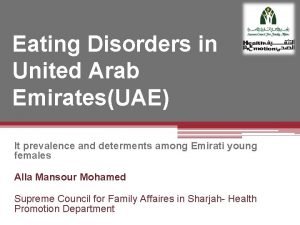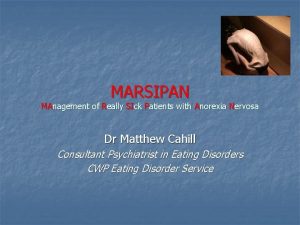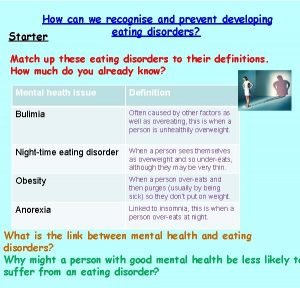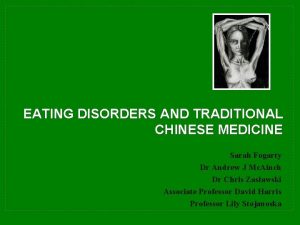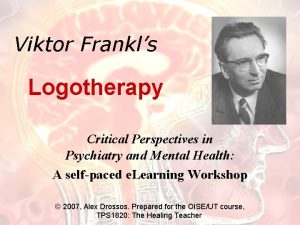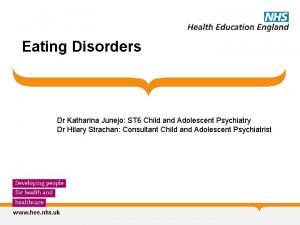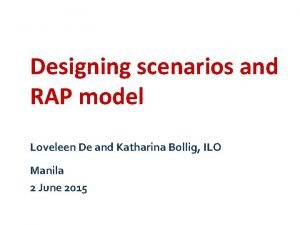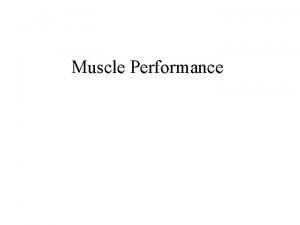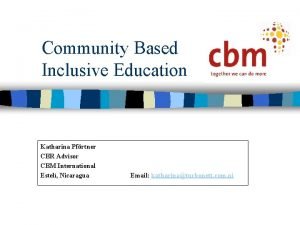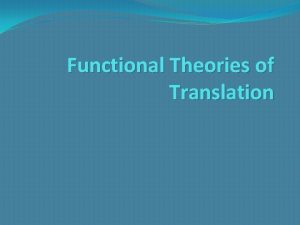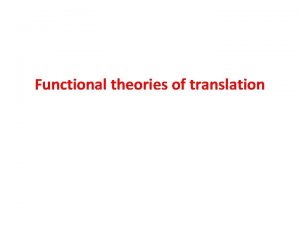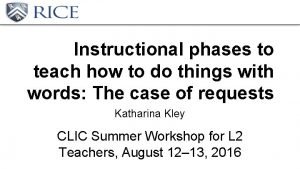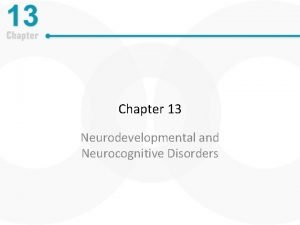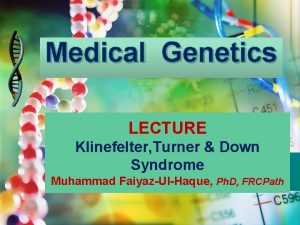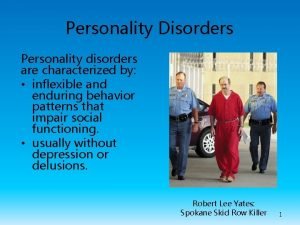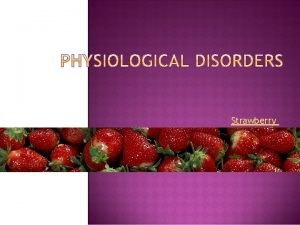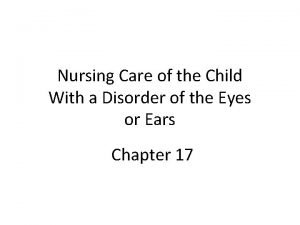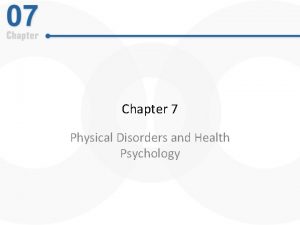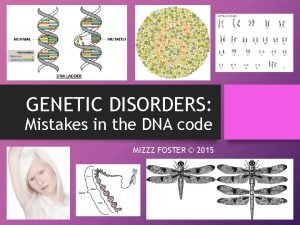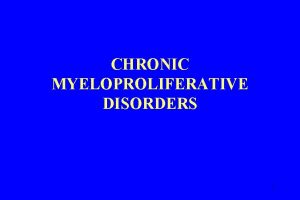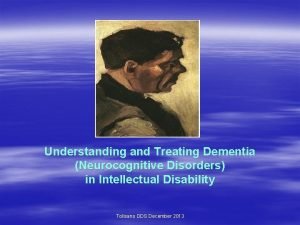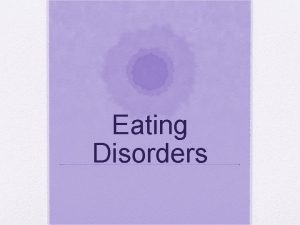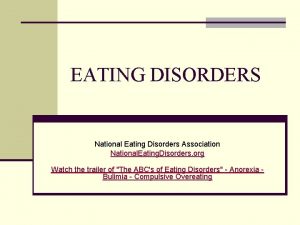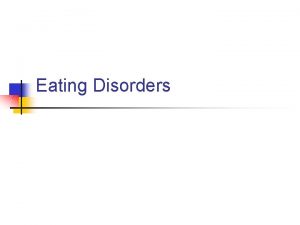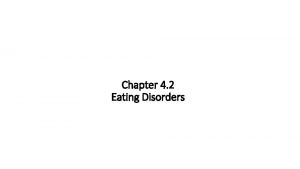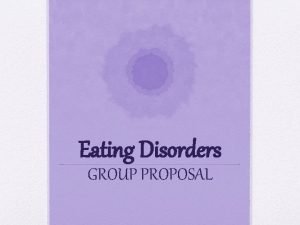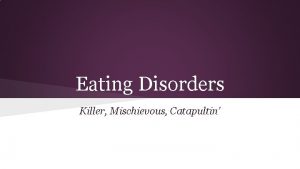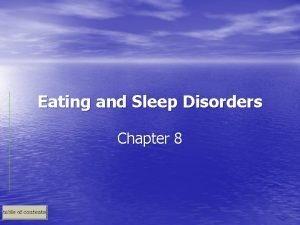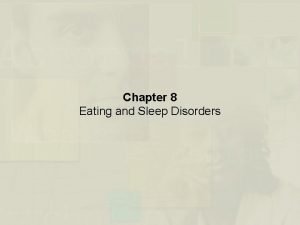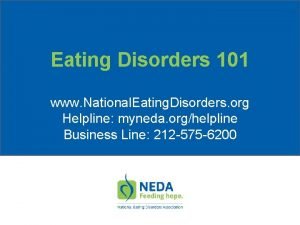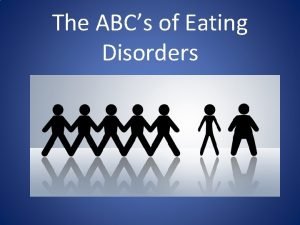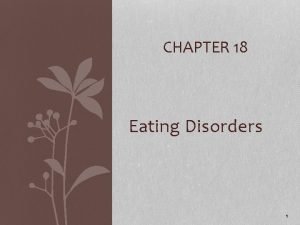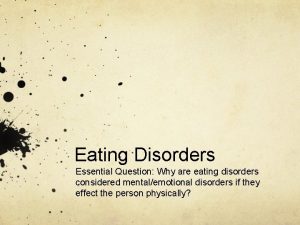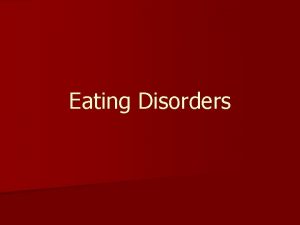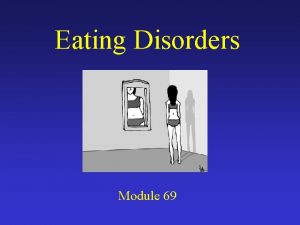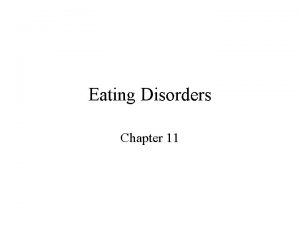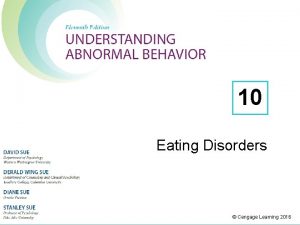Eating Disorders Dr Katharina Junejo ST 6 Child



















































- Slides: 51

Eating Disorders Dr Katharina Junejo: ST 6 Child and Adolescent Psychiatry Dr Hilary Strachan: Consultant Child and Adolescent Psychiatrist

Aims • Diagnostic criteria of Anorexia Nervosa • Assessing patients with AN • Medical and psychiatric management of AN incl. re-feeding syndrome • Diagnostic criteria of Bulimia Nervosa • Treatment of BN

Recent changes in DSM V classification: 2013 • The merging of feeding and eating disorders into a single grouping with categories applicable across age groups • Diagnosis can be made on the basis of behaviours (e. g. parental report of excessive exercise) that indicate fear of weight gain or other underlying fears or beliefs • Broadening of the criteria for the diagnosis of anorexia nervosa and removing the requirement for amenorrhoea • Inclusion of binge eating disorder as a specific category defined by subjective or objective binge eating in the absence of regular compensatory behaviour • Introduction of a new term, ‘avoidant/restrictive food intake disorder’ (ARFID), to classify restricted food intake in children or adults that is not accompanied by psychopathology related to body weight and shape (Bryant-Waugh 2010).

Anorexia Nervosa: ICD 10 • Weight loss or in children lack of weight gain, body weight 15% below expected BMI • Self induced weight loss by avoiding fattening food • Body image distortion with dread of fatness as intrusive, overvalued idea and patient imposes a low weight threshold • Endocrine disorder involving hypothalamic-pituitarygonadal axis: amenorrhoea, in men: loss of sexual interest. Exception: if taking the pill • If prepupertal: delayed development

AN: characteristics • The discrepancy between weight and perceived body image is key to the diagnosis of anorexia; anorexic patients delight in their weight loss and express a fear of gaining weight • Have changes in hormone levels which, in females, result in amenorrhea (if the weight loss occurs before puberty begins, sexual development will be delayed and growth might cease) • Feel driven to lose weight because they experience themselves as fat, even when at a subnormal weight • Intensely afraid of becoming fat and preoccupied with worries about their body size and shape • Direct all their efforts towards controlling their weight by restricting their food intake, may self induce vomiting, misuse laxatives or diuretics (purging behaviors), exercises excessively or misuse appetite suppressants

Epidemiology • Lifetime prevalence (adolescent girls) by age 20 was 0. 8% for anorexia nervosa, 2. 6% for bulimia nervosa, 3. 0% for binge eating disorder, 2. 8% for atypical anorexia nervosa (Stice et al 2013) • 1: 200 girls at age 16 • Common age of onset at age 15 (range 9 -24) • Females ten times more often affected than males • Highest mortality (cardiac arrhythmias and suicide) of any psychiatric disorder and standardised mortality rate ten times of normal population

Aetiology: 1 • Cultural factors: western culture fostering ideal of thinness and self- discontent. Tension may arise between fearing consequences of eating and easy available and appealing food. • Specific environmental risk factors: teasing about weight/shape by peers/family may moderate susceptibility; reinforcing cultural body ideals; loss of social connectivity during meal times • Perinatal risk factors : Hx of obstetric complications • Life events and precipitants • Cognitive vulnerabilities: problems with decision making, rigid thought processes, difficulties with self regulatory control, enhanced skill in processing details

Aetiology: 2 • Eating Disorders are familial • The risk of AN among mothers and sisters of probands is estimated at 4% or about eight times the rate among the general population (Strober et al, 2000) • A large twin registry study appears to confirm that BN and AN are related. This study found that the co-twin of a child with AN was 2. 6 times more likely to have a diagnosis of BN than were co-twins of children without an Eating Disorder (Walters and Kendler, 1995) • Twin studies confirm a genetic link. Studies of identical or monozygotic twins show concordance of up to 90% for AN and 83% for BN (Kaye et al, 2000) • Nearly all women in Western society diet at some point in adolescence or young adulthood, yet fewer than 1% develop AN

Differential diagnoses: Medical • Endocrine: diabetes mellitus, hyperthyroidism, glucocorticoid insufficiency • Gastrointestinal: coeliac disease, inflammatory bowel disease, peptic ulcer • Oncological: lymphoma, leukaemia, intracerebral tumour • Chronic infection: tuberculosis, HIV, viral, other • Rare -Kleine-Levin Syndrome (hyperphagia, hypersomnia, and irritability seen in adolescents with a self limiting course); • Rare- Kluver-Bucy Syndrome (limbic system dysfunction with visual and auditory agnosia, placidity, hyperorality, hypersexuality, hyperphagia, seen in Pick’s Disease, HIV Encephalopathy, Herpes Encephalitis, Brain Tumors, etc. )

Differential diagnosis: Psychiatric • Schizophrenia, MDD, OCD (ritualistic eating behaviors) • The majority of patients with an eating disorder will also meet criteria for another psychiatric disorder, most commonly MDD or a PD such as Borderline • Rates of OCD in anorexia is about 5 x the general population; OCPD found in 30% of parents of anorexics

Prognosis • Prognosis: average duration 5 -6 years • Severe illness markers: – – – – long duration severe weight loss purging type psychological problems difficulty gaining weight inability to restore normal weight as inpatient high expressed emotions within family


Clinical management of AN • Comprehensive approach: dietician, paediatrician, psychiatrist, psychologist, family therapist • Manage immediate physical risk • Weight restoration • Normalise eating patterns, re-establish normal perceptions of hunger and satiety, and correct the biological and psychological sequelae of malnutrition. • Malnourished patient may have single (e. g. protein-calorie malnutrition) or multiple deficiencies • Nutrients have highly variable stores in body and blood levels usually poor indicator of body store • Malnourished patients have low metabolic rate which goes up quickly during re-feeding

Physical Assessment Weight Height Rapidity of change in weight – previous ht/weight BP and P - Lying and standing Physical assessment – dehydration, temp, peripheries Full respiratory, cardiovascular, abdominal and neurological examination • Squat test – demonstrate and get them to copy • Episodes of collapse/dizziness fainting/chest pain/ shortness of breath/weakness – ask again • Having periods? • • •

What do you need to know immediately? Physical risk • What are they actually eating and drinking Breakfast/Lunch/Tea ? • How long for • Rate of weight loss • Vomiting/pills /laxatives • Bingeing • Exercise • Physical symptoms – though many deny/minimise Psychiatric risk • Self harm/suicidality – likely to increase as meal plan goes up • Likely adherence to treatment • Capacity/competence – will they agree to being refed on the ward?


Weight for height


Management of Really Sick Patients under 18 with Anorexia Nervosa Junior Marsipan guidelines (CR 168) • • • Risk assessment, physical examination and associated action Location of care and transition between services Compulsory treatment Paediatric admission and local protocols Management of re-feeding Management of compensatory behaviours associated with an eating disorder in a paediatric setting • Management in primary care and paediatric out-patient settings • Discharge from paediatric settings • Management in specialist CAMHS in-patient settings




Percieved risks for refeeding syndrome • Rate of weight loss prior to refeeding* (Crook, Hally et al. 2001; Boateng, Sriram et al. 2010; Raj, Keane-Miller et al. 2012) • The extent of malnutrition* (Ornstein, Golden et al. 2003; Raj, Keane-Miller et al. 2012) • Method of refeeding (enteral verse Parenteral) (Weinsier and Krumdieck 1981; Diamanti, Basso et al. 2008) • Carbohydrate load (Kohn, Madden et al. 2011; O'Connor and Goldin 2011); • Rate at which nutrition is introduced (Kohn, Golden et al. 1998; Whitelaw, Gilbertson et al. 2010) *Jnr MARSIPAN defines this as: < 70% Wf. H or 70 -80% Wf. H, or faster rates of wt loss of 500 -999 g for 2 consecutive weeks. Minimal or no feeding prior to admission, or commencing re-feeding – estimated intake c. 400 -600 kcals/day or severe restriction (less than 50% of required intake).


Why admit to Paediatrics/medical wards? High risk according to MARSIPAN • Risky physical state • Severe weight loss • Rapid weight loss – beware “normal weight” • Dehydration – restricting fluid intake • Physical complications – electrolyte imbalances, slow heart rate, refeeding syndrome • Refeeding admission – 2 weeks


Minnesota Starvation Experiment (Ancel Keys) • An experiment which ran from November 1944 until December 1945 that studied the physiologic and psychological effects of malnutrition and semi-starvation and the effectiveness of dietary rehabilitation on 36 healthy male “volunteers” (conscientious objectors from historic peace churches), as part of the American effort to re-feed populations that suffered malnutrition during the war.

Factors maintaining under-eating Safety behaviour, Compensation e. g. . exercise, vomiting Alienation of social norms Rule driven eating, avoidance Focus on detail of food rigidity Lack of variety and sufficiency: starvation effects High anxiety Homeostatic and hedonistic control fight back e. g. food more salient Appetite driven eating Others enforce eating Physically unpleasant, Appetite regulation disrupted, Violation of rules, neg. emotions

Psychological therapies • Engagement with patient and family • Motivational interviewing-assess readiness for change • Support Step by Step recovery: relearn how to eat sufficient, flexibly with variety, socially with food set in context of bigger picture • Family based therapy (Maudsley model) • Individual therapies: CBT-ED, psychodynamic psychotherapy, cognitive analytic therapy • Manage psychiatric comorbidities

Family based therapy: 1 • Family-Based Therapy (FBT) grew out of the work of Minuchin and has been developed at the Maudsley Institute in London • A problem-focused therapy that aims to change behavior through unified parental action. • The family in FBT is not viewed as the cause of the disorder but rather as a positive resource in the adolescent’s weight restoration and return to normal eating and health. • FBT takes no stance on disease etiology and tries instead to separate the pathology of AN from the adolescent herself.

Family based therapy: 2 • • • FBT focuses on family strengths The first phase of treatment - “Yp is too ill to make safe decisions about eating, parents are taking responsibility for this” The second phase begins when the child has reached 90% of ideal body weight and is eating without much resistance; at this point the parents are supported in returning the responsibility for their child’s eating back to the child. The final phase generally begins when the adolescent has achieved a healthy weight for age and height and focuses on the general issues of adolescent development and how the Eating Disorder affected this process. FBT, or the so-called “Maudsley Method, ” has been shown effective in 50 – 75% of adolescents, who in randomized trials achieved weight restoration by the end of treatment and maintained it for up to five years. In one trial of adolescents with a short history of illness, the response rate reached 90% (Eisler et al, 1997).

Medication • Evidence mainly comes from studies in adults • The evidence for use of medication in the treatment of childhood-onset eating disorders is limited, and the evidence for effectiveness is weak across the age range: • Atypical antipsychotics – beware cardiovascular risk. Used in high risk AN eg aggressively refusing refeeding requiring restraint • Selective serotonin reuptake inhibitors (SSRIs) – not effective at low weight

Bulimia Nervosa • An episode of binge-eating is characterized by both of the following: eating, in a discrete period of time, an amount of food that is definitely larger than most people would eat during a similar period of time and under similar circumstances • Sense of lack of control over eating during the episode (e. g. a feeling that one cannot stop eating or control what or how much one is eating). • Taking extreme measures for controlling shape or weight (e. g. self-induced vomiting, misuse of laxatives or diuretics, overexercising and intense dieting or fasting). • Extremely concerned about their shape or weight. • The binge eating and inappropriate compensatory behaviors both occur, on average, at least twice a week for 3 months.

BN: characteristics • Frequent episodes of binge eating, during which they consume a large amount of food within a short period of time • Feels overwhelmed by the urge to binge and can only stop eating once it becomes too uncomfortable to eat any more • Feels guilty, anxious and depressed, because they have been unable to control their appetite any they fear weight gain • Tries to regain control by getting rid of the calories consumed ( the most common method is vomiting, but they might misuse laxatives, diuretics or appetite suppressants, fast or excessively exercise)

Anorexia vs. Bulimia • Denies abnormal eating behavior • Introverted • Turns away food in order to cope • Preoccupation with losing more and more weight • Recognizes abnormal eating behavior • Extroverted • Turns to food in order to cope • Preoccupation with attaining an “ideal” but often unrealistic weight

Epidemiology • The prevalence rate of bulimia is 3 -8% in females 12 – 40 y; incidence <0. 1% • Bulimics face an increased risk of depression; anxiety disorders may also be increased • The lifetime prevalence of substance abuse/dependence among bulimics (particularly alcohol and stimulants) is at least 30% (25% among all patients with an eating disorder) • The diagnosis of a personality disorder among bulimics is not uncommon (especially Borderline PD)

Aetiology • Aetiology of eating disorders in line with most other psychiatric disorders is generally considered to be multi-factorial • If young person develops an ED will depend on individual vulnerability, consequent on the presence of biological or other predisposing factors, their exposure to particular provoking risk factors and on the operation of protective factors. • Eating disorders form a spectrum of clinical severity in which there is a continuum of familial liability

Genetic factors • Female relatives of those with bulimia nervosa were 3. 7 times as likely to suffer with bulimia • Fifty-four per cent to 83 per cent of the variance in liability has been thought to be due to common genetic factors (Bulik et al. , 2000), but again the confidence intervals around the estimation of heritability are broad, thus the relative contribution of genetic to other factors is unclear


Treatment • NICE recommends stepped care approach: as first line treatment to offer an evidence based self help programme, then CBT-BN adapted to need and development, as alternative to CBT offer interpersonal psychotherapy • Open label study, which treated adolescents for eight weeks with 60 mg of Fluoxetine per day, along with supportive psychotherapy. The study found decreases in binge and purge episodes, and 70% of subjects were rated as improved or much-improved by study’s end (Kotler et al, 2003).

MCQ 1 • When a child with anorexia nervosa refuses treatment that is deemed essential what do the National Institute of Clinical Excellence recommend? – A. The Mental Health Act should not be used where parents give their consent – B. Parental consent should be relied upon in cases of persistent refusal – C. A second opinion from an eating disorders specialist should be considered only as a last resort – D. If parents also refuse the treatment, the Mental Health Act should be applied – E. The Children’s Act should be considered under circumstances where parents also refuse treatment

MCQ 2 • What is the approximate ratio of girls to boys with a diagnosis of any Eating Disorder in the UK? – A. 5: 1 – B. 10: 1 – C. 15: 1 – D. 20: 1 – E. 25: 1

MCQ 3 • Which of the following is true? – A. In children, BMI is a stable measure of severity of Anorexia Nervosa – B. Children with Anorexia Nervosa can present with healthy weight – C. NICE recommend low dose fluoxetine for the treatment of BN – D. During treatment patients with Anorexia nervosa should be aiming for weight gain of more than 2 kg per week – E. Oestrogen administration should not be used to treat bone density problems in children

MCQ 4 • What medication do NICE recommend for Bulimia Nervosa? – A. Fluoxetine – B. Olanzapine – C. Venlafaxine – D. Methylphenidate – E. Mirtazepine

MCQ 5 • Which of the following is not a criterion for diagnosis of Anorexia Nervosa according to ICD 10? – A. Endocrine dysfunction – B. Fear of fatness – C. Over-exercise – D. Food restriction – E. Weight more than 15% below expected weight for age and height

MCQ 6 • All of the following are often present in both Bulimia Nervosa and Anorexia Nervosa except: – A. Food restriction – B. Self induced vomiting – C. Low weight – D. Purging – E. Episodes of overeating

MCQ 7 • Which of the following is a necessary early treatment for life threatening low weight in a young person with an eating disorder? – A. Feeding high calorie meals – B. Thiamine replacement – C. NG tube feeding – D. CBT – E. Psychotropic medication

MCQ 8 • Which of the following are features of anorexia nervosa (1 or more)? – A. Low FSH, LH an Oestradiol – B. Shortened QT – C. Delayed gastric emptying – D. Reduced Growth Hormone – E. Low T 3, normal TSH – F. Normocytic, normochromic anaemia

MCQ 9 • Which of the following are true about the long term complications of Anorexia Nervosa? – A. Pubertal delay is common – B. Osteopenia and osteoporosis are less frequent in children and adolescents than in adults – C. Catch up growth can occur with nutritional restoration – D. Hormone replacement is recommended for teenagers with Anorexia – E. Weight gain and the establishment of healthy eating habits usually results in restoration of menstruation

MCQ 10 • Which of the following are true regarding the prognosis of Eating Disorders: – A. Bulimia has a worse prognosis than anorexia nervosa – B. Vomiting in Anorexia Nervosa is a predictor if poor prognosis – C. The 30 year mortality rate in women with Eating Disorders has been found to be 20% – D. The mortality rate for Eating Disorders is greater than for psychiatric in patients – E. Some bone loss experienced in Anorexia Nervosa is irreversible

Answers 1. 2. 3. 4. 5. 6. 7. 8. 9. 10. D B B A C C B ACEF ACDE BDE
 Freud anorexia
Freud anorexia Kate moss eating disorder
Kate moss eating disorder Chimps eating termites
Chimps eating termites How to be anorexic
How to be anorexic Eat disorder york
Eat disorder york Managing weight and eating behaviors
Managing weight and eating behaviors Chapter 18 eating and feeding disorders
Chapter 18 eating and feeding disorders Hypothalamus eating disorders
Hypothalamus eating disorders Eating disorders in uae
Eating disorders in uae Isabelle caro before photos
Isabelle caro before photos How to spot eating disorders
How to spot eating disorders Sarah fogarty
Sarah fogarty Katharina kaska
Katharina kaska Eleonore katharina schwindt
Eleonore katharina schwindt Bulimia
Bulimia Katharina conradin
Katharina conradin Katharina blum zeitung
Katharina blum zeitung Informative, expressive and operative text types
Informative, expressive and operative text types Katharina bodirsky
Katharina bodirsky Konzil von trient unterrichtsmaterial
Konzil von trient unterrichtsmaterial Katharina manzke
Katharina manzke Katharina bollig model
Katharina bollig model Katharina schreyer
Katharina schreyer Katharina kircanski
Katharina kircanski Katharina hellebrandt
Katharina hellebrandt Katharina strach
Katharina strach Katharina kircanski
Katharina kircanski Katharina pförtner
Katharina pförtner Katharina kircanski
Katharina kircanski Be still my soul katharina von schlegel
Be still my soul katharina von schlegel Katharina reiss text typology
Katharina reiss text typology Functional theories of translation
Functional theories of translation Katharina kley
Katharina kley Katharina krainer
Katharina krainer Personalbeurteilungsverfahren
Personalbeurteilungsverfahren Katharina leiß
Katharina leiß 이진트리 복사 순회
이진트리 복사 순회 Chapter 15 anxiety and obsessive-compulsive disorders
Chapter 15 anxiety and obsessive-compulsive disorders Neurocognitive disorders
Neurocognitive disorders Sleep disorders
Sleep disorders Monosomy x
Monosomy x Nursing care for gastrointestinal disorders
Nursing care for gastrointestinal disorders Chapter 21 mental health diseases and disorders
Chapter 21 mental health diseases and disorders Psychological disorders characterized by inflexible
Psychological disorders characterized by inflexible Strawberry physiological disorders
Strawberry physiological disorders Nursing care plan for conjunctivitis slideshare
Nursing care plan for conjunctivitis slideshare Physical disorders and health psychology
Physical disorders and health psychology Chromosomal mutation
Chromosomal mutation Puberty and autism spectrum disorders
Puberty and autism spectrum disorders Myeloproliferative disease
Myeloproliferative disease Neurocognitive disorder
Neurocognitive disorder Pelvis protraction
Pelvis protraction
